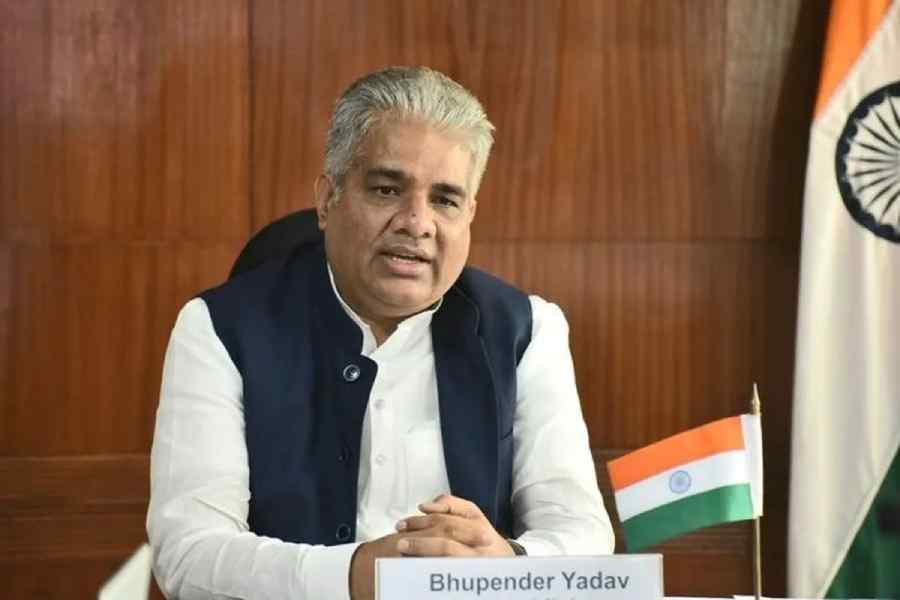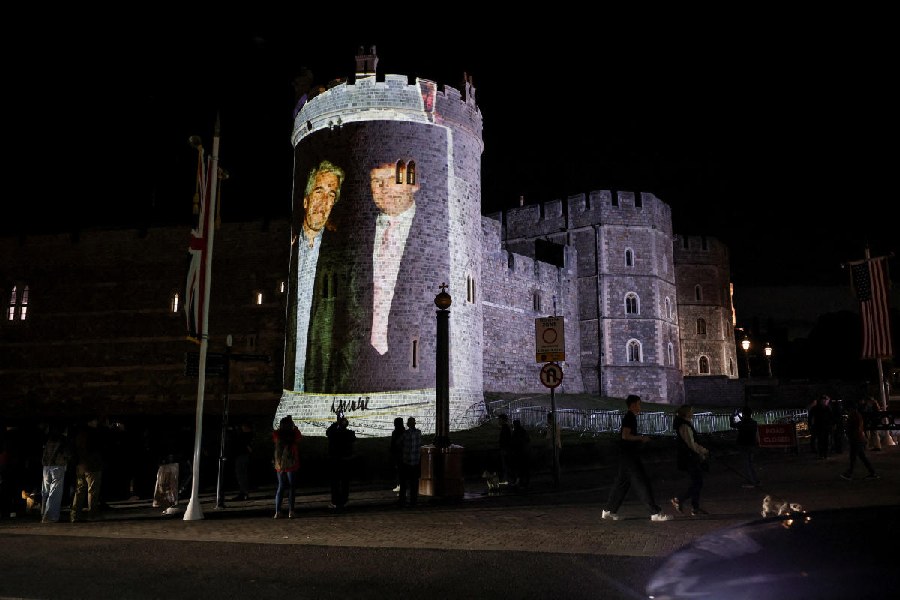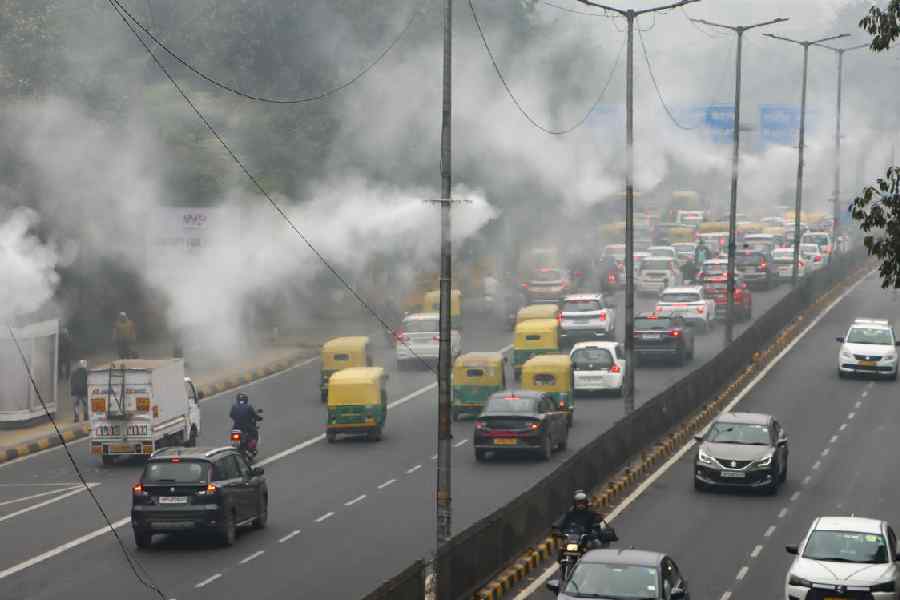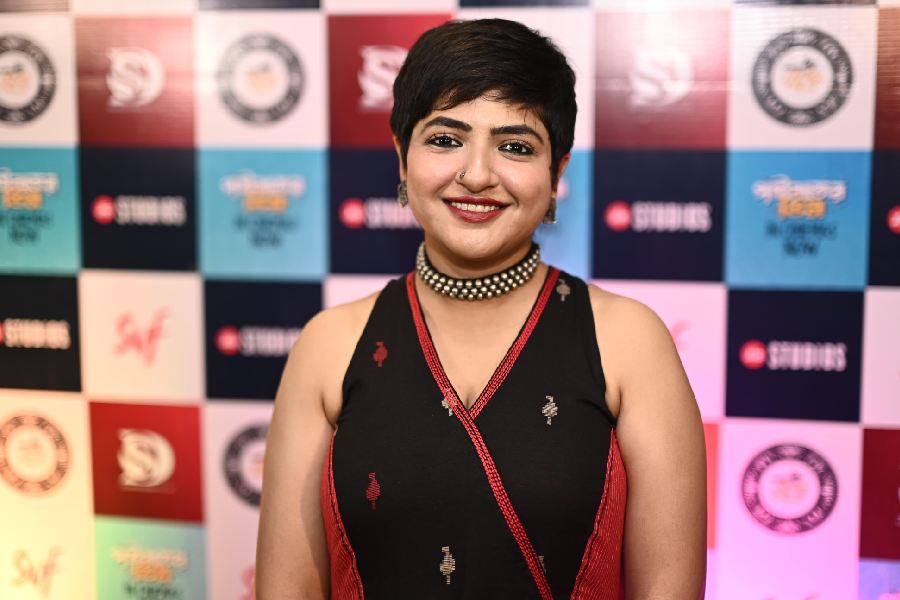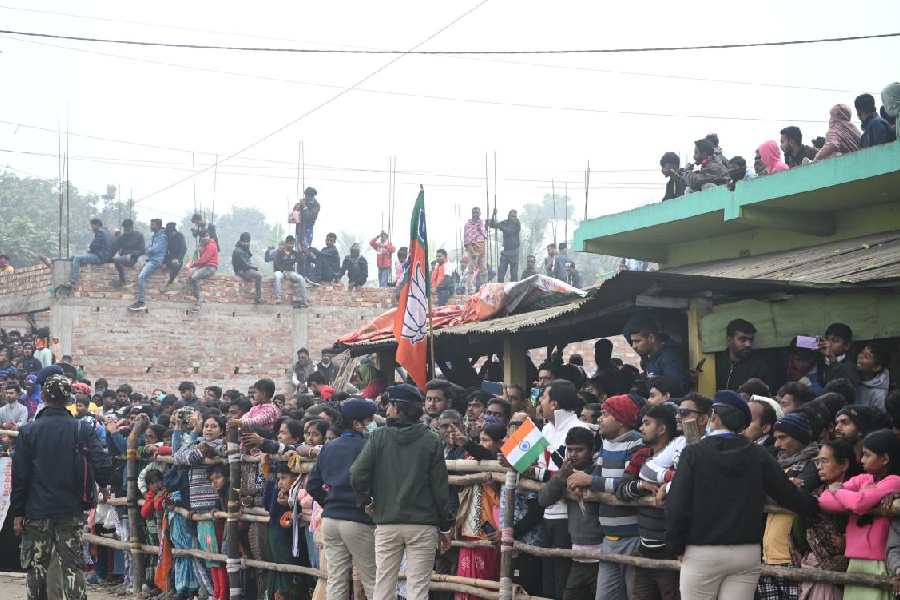 |
 |
| Pix by : Gajanan Dudhalkar Airport spaces devoid of human presence, yet showing signs of occupation, are a recurring motif in New York-based artist Kanishka Raja’s (above) paintings like Cruise (Green Stripes) (top) and Escalate (Grey Stripes) (below) Pictures courtesy: Galerie Mirchandani + Steinruecke |
 |
It’s a recurring motif in artist Kanishka Raja’s canvases. A sprawling but empty airport terminus with a slightly ominous air. The viewer stands almost on the edge looking at the desolate scene — there are never any people in these man-made palaces to aviation but there are signs of human occupation such as refugee tents and cots.
Aji V.N., meanwhile, has a very different take on our globalised world. He creates landscapes and seascapes that depict both his native Kerala — and the Dutch countryside — with equal elan, using charcoal on coloured paper.
Raja, who lives in New York, and Aji, who’s based in Rotterdam, are part of a new far-flung Indian diaspora of artists who’ve shifted to different corners of the globe and have still retained a visible and unmistakeable Indian touch in their work.
“When you live in another country, you develop a different perspective. So it’s interesting to see how an artist processes these influences,” says Ranjana Steinruecke of Galerie Mirchandani + Steinruecke, where Raja’s first solo show in India, I Have Seen The Enemy And It Is Eye, is on currently.
As the Indian art world scours the globe for new talent, it is discovering young stars who are making their name far away from home.
So you have Los Angeles-based artist Bari Kumar, who recently showed at Calcutta’s Bose Pacia gallery. And Oman-born London-based Radhika Khimji just held her first solo show in India at Nature Morte Annex Shivalik in Delhi. Khimji, 29, is an upcoming star who explores how “various media inform each other and what are the boundaries between sculpture and painting and drawing”.
Next month, Delhi’s Vadehra Art Gallery will hold a show by Praneet Soi, who lives and works between Amsterdam and hometown Calcutta. Soi held two shows at Project 88 in Mumbai last year. Now, his Delhi show, a continuum of his explorations, will include mural, sculpture and painting.
Back in Mumbai, Chatterjee & Lal gallery has just shown works by diaspora artist Chitra Ganesh, whose visual language borrows from the Amar Chitra Katha and Bollywood. The Ocean Beneath was the New York-born-and-bred artist’s first solo show in India. And next month, the gallery will show another diaspora artist, Hitesh Natalwala, who explores the ideas of a post-Colonial transnational life in his paper collages. Natalwala’s family moved from East Africa to England, where he studied art. He now resides in Australia.
 |
 |
 |
| Rotterdam-based artist Aji V. N.’s (top) charcoal-on-coloured-paper drawings, like Yellow # 2 (middle) and Three Men (above), have a meditative quality Pictures courtesy: Aji V.N. /Nature Morte/Galerie Mirchandani + Steinruecke |
Of course, Indian artists, most famously S.H. Raza and F. N. Souza, have lived abroad before. “You could see the effect it had on artists like Raza, who searched for ways to reconnect with their notion of being Indian,” says Prajit Dutta, partner, Aicon Gallery.
But things have changed since then. “Earlier, artists tried to get a break in the West. Today, India is a focus centre of the art world,” says Sree Goswami, director, Project 88.
Indeed, for many diaspora artists, it makes sense to show in India. And some of them already visit India frequently in pursuit of their art. For Indian art lovers too, it opens up a fresh body of work, which is also reasonably priced. For instance, works of artists like Raja, Aji and Soi are priced between Rs 5 lakhs and Rs 10 lakhs. Indian artists like Bose Krishnamachari and Sudarshan Shetty sell for between Rs 15 lakh and Rs 30 lakh.
The diaspora artists don’t want to be pigeon-holed into any nationalistic category though. Rather, they insist they’re artists first, and their themes are global too.
Says Aji, who’s married to Dutch artist Juul Kraijer and who spends a lot of time in India, “I’m an artist with no tags attached. I have an audience in Europe as well as in India. I believe in an art which inspires every individual beyond their differences.” Aji’s show, which was on at Nature Morte last month, will travel to Galerie Mirchandani + Steinruecke in March.
Chatterjee & Lal’s Mortimer Chatterjee believes: “There’s a breadth of experience which artists living abroad bring to their work.”
Take Soi, who grew up in Calcutta, studied art at MS University, Baroda, then did another masters at University of California, San Diego, before moving to Amsterdam for a residency at the famous Rijksakademie in 2002.
 |
 |
| Upcoming artist Radhika Khimji likes to explore the “boundaries between sculpture, painting and drawing”. Her paper works were hung on hinged metal frames at her solo show, B-Sides, in Delhi Pix by : Jagan Negi |
Naturally, these experiences shaped him. For instance, he was influenced by the hunt for a visual language by Baroda artists like Gulammohammed Sheikh and Bhupen Khakhar.
In San Diego, famed documentary filmmaker, Jean-Pierre Gorin, introduced him to the medium. “When I left India, I didn’t have any idea of contemporary art practice or discussions about conceptual art. But a rich diet of documentaries helped me to enter that discussion,” he says.
He also realised in San Diego that “I was looking at image in relation to everyday life and that I was interested in commenting on events”. “This was my narrative voice,” he says.
That voice has been strengthened by his “moving between Europe and India” and exposure to “notions of progress and globalisation, immigration — and terror”.
“You’re constantly seeing different aspects of an issue,” says Soi, who uses varied media from Indian miniature to mural to sculpture and who set up an artist exchange programme, Calcutta Art Research, three years ago.
 |
 |
 |
| Praneet Soi (top) questions “notions of progress, globalisation and terror” in works like Angelus Novus (middle), and Crippled Leads The Blind (above), which were part of his Juggernaut show at Project 88, Mumbai Pictures courtesy: Project 88/Praneet Soi |
Like Soi, Raja too comments on contemporary reality, especially on the themes of migration, dislocation and terror. Hence, the airport motif is “a particularly resonant kind of repository” for him. “It’s a structure inside which I can put a lot of ideas because it’s quite an in-between space of arrival and departure, a mid-point in the journey of immigration and emigration that’s so much a part of contemporary reality,” he says.
It would be simplistic to directly link this to Raja’s own journey from Calcutta to study art in the US at 18, of course. Growing up in Calcutta, he recalls being surrounded by political graffiti. His parents designed saris, unself-consciously borrowing “ideas from a variety of cultures and sources”, and they were a sub-conscious influence too.
“I think that gives you the licence to think that things around you are perfectly valid source material,” he says.
His work is rooted in “a documentary impulse”. “I use current events-based ideas as source material. So, I think of what I do as contemporary history painting,” he says.
Aji’s drawings, meanwhile, have a meditative quality. He grew up drawing on the sand in front of his house in Kerala. Later, he studied art at the Trivandram College of Fine Arts. In the early 1990s, he moved to Delhi, where he spent hours at the National Museum and attending classical music concerts, which spurred his interest in “spirituality, the self, the occult and Indian imagery”.
Aji’s subjects “are usually very basic: a plant, a shoreline, a human body, a stretch of rocky earth”. Curator Grant Watson describes his works as “dense, powerful compositions in which every corner is charged with presence”.
And he uses “minimal means” too: charcoal on coloured paper. Aji, who moved to Rotterdam in 2000, began working on coloured paper three years ago because he was interested in the optical effects that colours can have.
“Juxtaposing drawings of different colours can induce optical effects. An eye saturated with luminous blue perceives brown in a different way. My works need a meditative mind to enjoy their subtle content, so I use optical possibilities to try to induce this meditative awareness in the spectator,” he says.
Many diasporic artists have turned to pop images from India, although the best works go beyond nostalgia. “Sometimes, artists living outside India may be more attracted to subject matters which artists living here feel are cliched,” says Nature Morte’s Peter Nagy.
 |
 |
| (Top)A still from Chitra Ganesh’s film, Ghost, shown at Mumbai’s Chatterjee & Lal gallery last month, and (above) For The First Time She Threw Her Precious Reserve To The Wind, a work by diaspora artist Hitesh Natalwala Pictures courtesy: Chatterjee & Lal |
Artists like Chitra Ganesh, who deals with themes of gender and sexuality, for instance, have used images from Bollywood like in the prints using Zeenat Aman’s disfigured image from the film, Satyam Shivam Sundaram, in her Mumbai show.
Says Chatterjee, “Sometimes the most obvious things are the most important. Chitra’s visual language is really sophisticated and her perspective is very fresh.”
On the other hand, Khimji is “interested in how things get defined and named” and in the relationship between painting and drawing. Her paper works with their “quirky” figures on an abstract patterned base were hung on hinged metal frames at the Delhi show. “I do works that can be moved around so they perform differently in different spaces,” he says.
Khimji, who grew up in Muscat, studied art in London. Being from India and Oman and living in London, she says, “has made me aware of how culture can become commoditised. I question that in a lot of my work” — and often humorously.
While the diaspora artists are now showing in India, they’ve been gaining recognition overseas. Soi, for instance, is represented by a respected Amsterdam gallery, Martin Van Zomeren, and his work is in private collections in Europe and America.
He showed at the Gwangju Biennale in Korea under its artistic director Okwui Enwezor, a leading curator, recently. Now, he’s doing a show at the Van Abbe Museum in Eindhoven with its curator Charles Esche, which will be on for six months. Esche is writing a book on him too.
 |
| Amar Prem, a work by Los Angeles-based artist Bari Kumar, who showed at Bose Pacia, Calcutta, recently Picture courtesy: Bose Pacia/Nature Morte |
Aji’s audience too has grown. His works were collected in The Netherlands even before he moved there in 2000. Now, it’s appearing in institutional collections like the Stedelijk Museum in Amsterdam.
And Raja, who won the Digitas prize from the Institute of Contemporary Art in Boston in 2004, too has participated in various shows globally, including a two-gallery solo show at the Jack Tilton and Envoy galleries in New York in 2007.
Back home, meanwhile, interest in the works of the diaspora artists is only just beginning. But it’s bound to grow.


